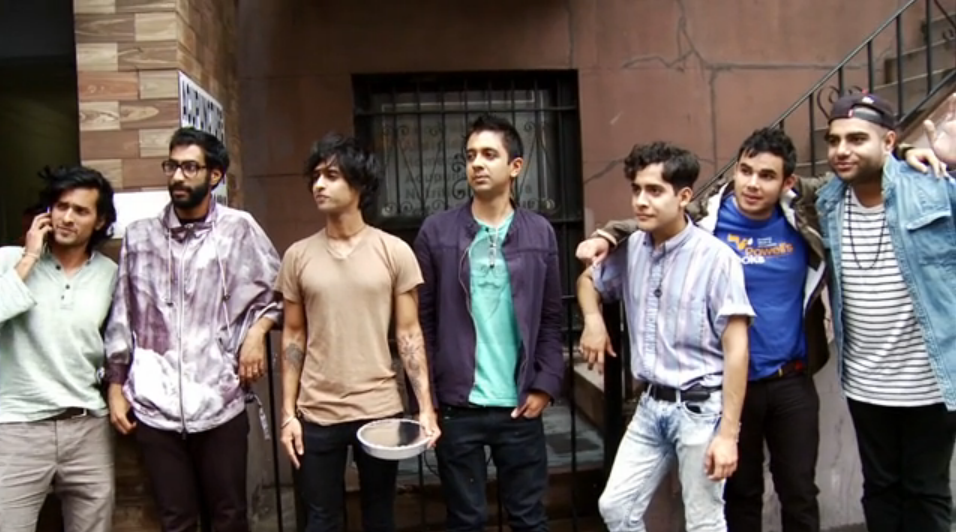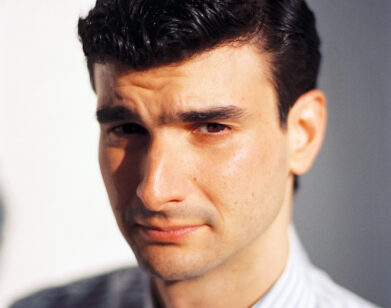Amrit Singh Puts the Indie in Indian Food

ABOVE: AMRIT SINGH (THIRD FROM LEFT) AND HIS DOSA HUNT COMPATRIOTS IN A SCENE FROM THE FILM
If the word “drumstick” has no meaning to you outside of percussion and poultry, then chances are you’re not up on Indian food (a drumstick is a vegetable that’s popular in South Asian cooking). You might not even be familiar with dosa, the tasty crepe that’s usually served with potatoes and chutney and is a South Indian staple. A fine way to school yourself on both—and be entertained by some of the more talented men in indie rock in the process—is to check out Dosa Hunt, a new short by filmmaker and music journalist (and Stereogum’s Executive Editor) Amrit Singh.
Last August, Singh piled into a van with six of his music-luminary pals—Indian-Americans Himanshu Suri and Ashok Kondabolu of Das Racist, Anand Wilder of Yeasayer and jazz artist Vijay Iyer of the Viyjay Iyer Trio, Mexican-born Alan Palomo of Neon Indian, and Persian-American Rostam Bamanglij of Vampire Wekend—to tool around New York in search of good, authentic dosa. It’s a multi-culti hang that’s part No Reservations, part Big Brother, part something smarter, with lots of laughs, something to learn, and—naturally, given the company—an amazing soundtrack.
This weekend, more than two years after a tweet from Batmanglij first sparked the idea for the film, Dosa Hunt will premiere with three screenings at Brooklyn’s Nitehawk Cinema. There will be tunes, Kingfisher beer, and yes, dosa will be served. When we caught up with Singh, he was still in an edit bay, making final tweaks to the film.
JOHN NORRIS: Amrit, I know you’ve been working like a madman on this, so it doesn’t surprise me that you’re still in an edit.
AMRIT SINGH: Yeah, man, I have been working on this project almost every single day for the last year, and it’s really down to the wire. We were here ‘til like three or four last night. We were a little nervous for the last 12 hours about some things with the sound mix. We got it taken care of, but at this point we’ve worked on it so long that we just want it to be as perfect as possible.
NORRIS: Well I’m sure it will be great this weekend, not least because you’re serving dosa at the screenings. How did that idea come about?
SINGH: I think that right from the get-go, thinking about making a “food film,” I was like, as long as whatever we wind up capturing that day holds up, to the point where we could actually screen it and not feel like we were wasting people’s time. And the idea was that the premiere screening should be kind of an immersive, interactive experience. Part of the allure of the project is that dosa is a somewhat lesser-known Indian food, and that’s partially due to the history of Indian people coming to America. In the ’60s, there was this wave of immigration that came about because immigration policy changed to allow for more technically skilled Indians to come in. And that wave was North Indian, so that’s the impression that most people have of Indian food in the States. But now that Indian culture and awareness of India is on the rise globally, there’s a new eye being cast toward South Indian culture, and dosa. And that’s part of my fascination with it, because I’m North Indian, I’m Punjabi. So going into it, I knew that people knew their tikka masala, and their samosas and stuff, but they didn’t know their dosa, and that part of the allure would be that people would be learning about this new food. Also, watching people eat and not eating yourself is really not that much fun. So serving dosa became the vision for the premiere screening, and that’s a vision I would like to uphold any time we screen this film.
NORRIS: Speaking of “discovering” dosa, at least one of your cast members, Alan from Neon Indian, discovered it for himself on the day of the shoot.
SINGH: Well, none of us are perfect experts on dosa. But we were all somewhat experienced with the food to varying degrees, except for Alan, who had never had a dosa before. And that really pleases me, because he winds up sort of being this avatar for those who are watching the film and can relate to his experience of being a bit wide-eyed and needing to be told what was happening a little bit. So that created a dynamic where we were being explanatory in a way that was organic and not just for the sake of the cameras. And even for me and Himanshu, we’re North Indian, our families are from Punjab, but we were the ones who were most fanatical about the food, and really wanted to do this for a long time. Whereas Ashok, Vijay, and Anand all have South Indian heritage to some degree, and they know a good bit about dosa from their childhood. But I think the fact that we’re asking people about the food as we go, and we’re curious about ingredients, it allows the whole experience to be relatable.
NORRIS: And likewise, having Rostam there, he’s sort of inquisitive in other ways. There’s scenes where his questions about Indian culture and perceptions of things like Slumdog Millionaire prompt some good exchanges. And of course it was a tweet of his in 2010 that sort of sparked this whole thing, right?
SINGH: That’s true. Rostam is a pivotal figure in the whole “hunt.” Like you said, because the genesis of the entire project was that he sent this tweet more than two years ago saying, “Eating a dosa,” which I immediately replied to. But his dosa ingredients were like arugula and jack cheese, and it was so clearly a fusion dosa, and I was like, “We should go for real dosa sometime.” And then Himanshu jumped in and said, “You’ve gotta go to Queens for dosa,” Vijay jumped in, that conversation led to an e-mail thread and eventually the film. Rostam is both one of the most intelligent people I’ve ever met, and very confident, but he’s also got a humility when it comes to that sort of thing. And there’s a few moments in the film when we jump on the things he is saying, purporting to be true, and people will see it, but one of the key claims he makes about religious life in India, we just say, “That is so wrong!” We jump all over him in a really comical way, and he was a really good sport about it. But then, later on we learned that in fact, he was right! So at the end of the film, as a director, I had to give him a big ol’ apology. But see, that is analogous to the whole project in a sense, which is very much about learning more than you thought you knew.
NORRIS: You’re a Sikh-American, and it’s an interesting time, when as you said earlier, Indian culture is so on the rise, and Indian-Americans are more prominent than ever, as you guys illustrate. On the other hand there was the horrific Sikh temple shooting in Wisconsin in August, which you wrote a really moving piece about as well. Do you feel like a curator in a way, or do you see this film as having that kind of larger purpose?
SINGH: I did from the beginning, but I kind of kept that to myself. Because it began as, we were just going to get this little brown indie fraternity together—we were all friends to varying degrees, had hung out over the years, but the seven of us had never gotten together before that day. So there’s a bit of a “getting to know each other” spirit to the film too, which really helps it along and makes it more enjoyable. So for the guys, it was like, “yeah, we’re just gonna go get some dosa.” For me, it was like, here was this compelling cast of multi-cultural artists that just couldn’t have existed a decade ago. So I’ve thought about it a lot, especially as Das Racist has enjoyed their ascendancy in pop culture. Because they’re so overt and explicit about their experience as brown dudes in America, and so much of their stuff is like an identity-based art project.
And I see Hima becoming this galvanizing figure in a way for young kids who are kind of discovering themselves, and I think it feels good for them to have someone who’s thinking about the same stuff that they are, or their experience of sometimes feeling weird, and trying to figure out who they are in the context of a culture here in America, where race discussion tends to be so binary, so black and white. But it’s nice to have some brown dudes coming up, either by virtue of simply existing in the public eye, or some even taking the additional step of actually talking about their experience. Either way it’s a transitional and transformational time in that regard. And so many of those guys are my friends, because they are making art inside the world that my website focuses on. So I’ve come to know them over the years, and I appreciate them as artists and as people. I’m a music fan. You know, I’m still that 15-year-old kid loving music, and I’m just so proud. I don’t like Yeasayer because there’s a half-Indian guy in Yeasayer. But I like the band, and the fact that there’s a half-Indian guy in there makes it that much more compelling. I’m like, “Wow, that’s amazing.”
NORRIS: And in its own way, the film reflects that pride.
SINGH: Yeah well, this movie wasn’t created to make money. The way I’ve approached it, it’s a passion project, and I did feel like I was making a cultural artifact, and I hope that that’s true. And this may sound really pretentious but I feel like it’s a time capsule of sorts, and I think it will matter to people for a while. And as the immigrant experience evolves even more, people can look back and maybe just get a flavor for what was happening then.
NORRIS: I have to ask you about this amazing poster, which should look familiar to people who know Bollywood films at all. The artwork is by your tattoo artist?
SINGH: Anil Gupta. He is my tattoo artist, but it goes deeper than that, and I don’t know how best to characterize it. I feel goofy calling him my guru, but people have called him that when they see us interact. He’s one of the most remarkable people I have ever met, and from an artistic standpoint, the man is truly limitless. When I first told him about Dosa Hunt has was like, “Oh, let me tell you all about it.” He’s the one who recommended one of the restaurants we visit, Pongal, and he gave me this sheet that talked about the crepe, the aloo masala, which is the potato, the sambar, which is the veggie stew, the condiments. It was this really orderly schematic, a blueprint for how to approach the evaluation of the dosa. And I could tell that for him, he found something really fun about the project. So when it came time to release the trailer, we needed a logo for the film, and a poster, and when I went to him, I told him I just wanted to play with a Bollywood-type theme, and I wonder if he could do that kind of poster for me. And he just said, “You have no idea who you came to talk to about this.” It turns out his father was C. Mohan, who’s the most storied publicity designer in Bollywood history, he’s done huge blockbuster films, he’s had a hugely successful career for like 30 years. And Anil learned his art painting huge Bollywood billboards with his father. So he came back with a Dosa Hunt logo which totally pays homage to [’70s Bollywood epic] Sholay, and when people see it, they’re like, “That’s just like Sholay!” It’s great, because it’s orange and cracked, just like dosa, and Sholay is based on The Magnificent Seven, and there’s seven of us in the movie, so it’s perfect.
DOSA HUNT PLAYS THIS FRIDAY, SATURDAY, AND MONDAY AT BROOKLYN’S NITEHAWK CINEMA. FIND OUT MORE AT THE FILM’S WEBSITE.






